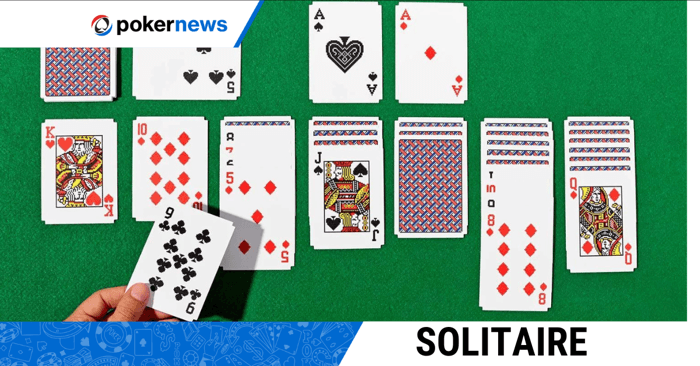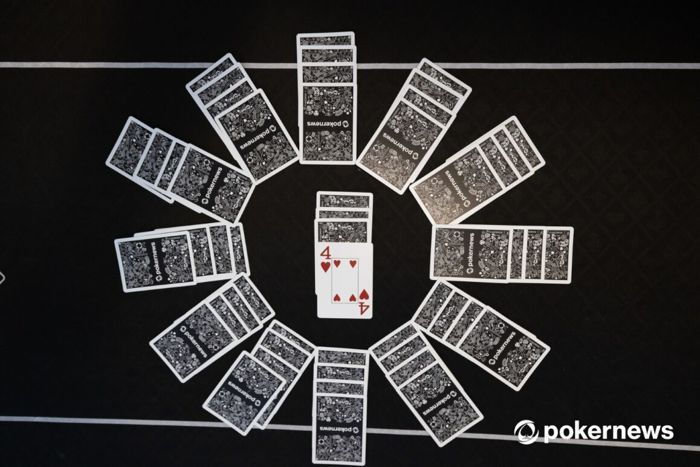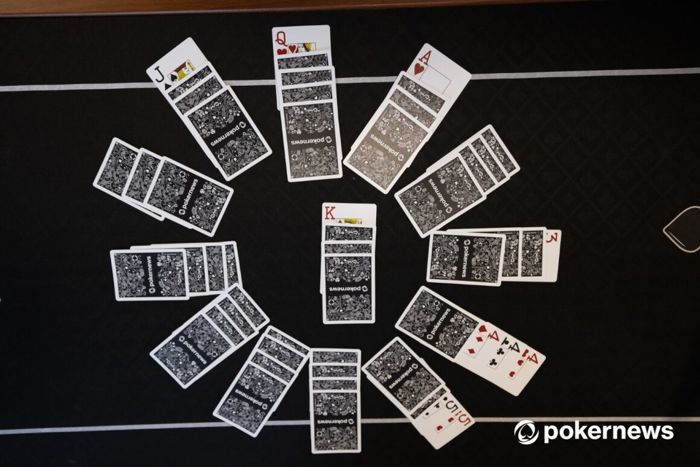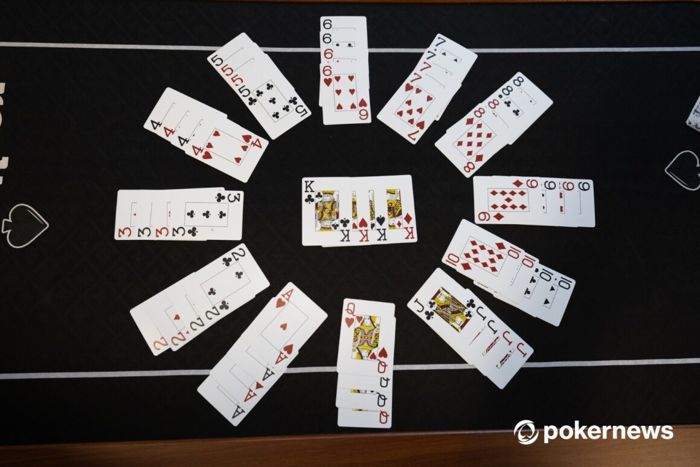Clock Solitaire - What is it and How to Play

Clock Solitaire is a variant of the traditional game of Solitaire but with a unique twist. Cards are set out in a clock formation, rather than the standard columns. Ultimately, the gameplay is very different, yet it's equally as enjoyable. So, here is everything you need to know about Clock Solitaire.
The Basics - What is Clock Solitaire?
Clock Solitaire stands out among solitaire variants due to its distinctive setup and gameplay. The game begins by arranging the cards in a clock-like pattern, with one card at the center (representing 12 o'clock) and the rest positioned in a circle around it, following the numbers on a clock. The objective is to match each card drawn from the deck to its corresponding position on the "clock."

Players draw cards from the deck and place them face-up, one at a time, aiming to match the card's rank with the number on the "clock." For instance, drawing a 5 of hearts would be placed at the 5 o'clock position. The game continues until all 13 cards are placed on their respective positions, successfully "completing" the clock.
Unlike classic solitaire, Clock Solitaire lacks the tableau and foundation piles. It relies solely on the clock layout and the matching of cards to their designated positions. Its unique aspect lies in its simplicity and focus on matching cards to specific locations rather than building suits or sequences. This simplicity makes it an accessible game for beginners, offering a different challenge compared to other solitaire variations.
Clock Solitaire’s appeal lies in its straightforward gameplay and the challenge of accuracy in matching cards to their positions within the clock. Its distinct layout and objective provide a refreshing change for solitaire enthusiasts seeking a different kind of solo card challenge.
How to Play Clock Solitaire - Clock Solitaire Rules
Clock Solitaire offers a distinctive challenge with its simulation of a clock layout. To set up the game, arrange the cards in a clock-like pattern, with one card at the center representing 12 o'clock, and the remaining cards positioned in a circular fashion following the numbers on a clock face. Shuffle the deck and place it face-down beside the arranged "clock."
The gameplay involves drawing cards one at a time from the deck. Each drawn card symbolizes a specific clock position based on its rank, and it should be placed face-up on the corresponding number. For example, a 5 of hearts would be placed at the 5 o'clock position.

The objective is to match each card's rank with its designated position on the clock. As cards are drawn, accurately place them on their respective numbers until all 13 positions on the "clock" are filled.
The game concludes when all 13 cards have been successfully placed on their designated positions, resulting in a fully filled clock face. This unique variant of Solitaire adds a thematic and strategic twist to the traditional gameplay, making it an engaging and enjoyable experience for players.
Top 8 Clock Solitaire Tips and Strategies
Clock Solitaire presents a unique challenge with its clock-like layout, and mastering it requires a combination of observation, memory, and strategic decision-making. To succeed in Clock Solitaire, start by observing the clock layout to anticipate potential card placements, recognizing patterns that aid in predicting the next card’s position.
Develop a strong memory for the cards drawn and their positions on the "clock," emphasizing accuracy in matching ranks to their respective numbers. Mentally follow a sequence while drawing cards to efficiently recall which numbers/cards are yet to be drawn. Prioritize troublesome positions early in the game, focusing on those with fewer matching cards in the deck to prevent potential difficulties later on. Maintain composure, especially as fewer positions remain, staying attentive to drawn cards and their potential placements.
Optimize decision-making by taking a moment to reconsider uncertain card placements, preventing potential errors. Patience and concentration are key in Clock Solitaire, so stay persistent, and with practice, both accuracy and speed will improve. Experiment with different approaches, adapting strategies based on observations and experiences to find what works best for you in this unique solitaire variant.
By implementing these strategies, you'll develop sharper memory skills, better pattern recognition, and a more efficient approach to placing cards accurately on the clock. Practice and patience are key—over time, your proficiency in Clock Solitaire will greatly improve.
Common Mistakes to Avoid in Clock Solitaire
Clock Solitaire demands skill and strategy, and while winning is achievable, players often make common mistakes that can hinder success. One key error is misplacement due to hastiness—rushing to place cards on the clock can lead to incorrect placements. It's crucial to avoid haste and take a moment to ensure each card aligns accurately with its corresponding number.

Inaccurate memory is another common pitfall. Failing to remember which cards have been drawn or their positions on the clock can significantly hinder progress. Enhancing memory recall by focusing on the cards drawn and their placements is essential.
Neglecting troublesome positions is another mistake to avoid. Ignoring positions with fewer matching cards in the deck can create difficulties later in the game. Prioritizing these positions early on helps prevent potential obstacles toward the end.
Lack of pattern recognition is another common error. Overlooking patterns in the clock layout might result in missing opportunities for predicting upcoming placements. Training your eye to recognize recurring sequences or placements is key.
Finally, losing focus due to distractions can lead to errors. Maintaining concentration is crucial to ensuring accurate card placements and preventing the oversight of important details. By avoiding these common mistakes, players can significantly improve their chances of success in Clock Solitaire.
To improve your Clock Solitaire experience, avoid rushing placements, enhance memory recall, prioritize challenging positions, train pattern recognition, and maintain focus throughout the game. By sidestepping these common pitfalls, you'll refine your skills and enjoy a smoother and more rewarding gameplay experience.
Clock Solitaire’s appeal lies in its unique layout and the challenge of accuracy in matching cards to their designated positions. Mastery requires a blend of memory, pattern recognition, and a calm, focused approach. While simpler in its setup compared to other solitaire variants, Clock Solitaire demands precision and attention to detail. Practice and perseverance will aid in mastering this engaging and distinct solitaire experience.
There are several variants of Solitaire, and Clock Solitaire is just one of them. Be sure to check out Klondike Solitaire, Pyramid Solitaire, Freecell Solitaire and other variants.
FAQs for Clock Solitaire:
How is Clock Solitaire different from traditional Solitaire?
Clock Solitaire diverges significantly from traditional Solitaire in its gameplay and structure. Unlike the classic version that involves building suited stacks or sequences, Clock Solitaire revolves around a distinct layout resembling a clock face. The game doesn’t feature tableau or foundation piles. Instead, it tasks players with drawing cards and placing them on specific positions matching the clock's numbers. The objective is to accurately match each card’s rank to its designated position, eschewing suits or sequences. This unique approach in Clock Solitaire emphasizes precision in card placement rather than building sequences, setting it apart from the traditional Solitaire's stack-focused gameplay.
What is the objective of Clock Solitaire, and how do I win?
Provide a clear explanation of the goals in Clock Solitaire and the conditions for a successful completion of the game.
In Clock Solitaire, the objective is to place all 52 cards onto the clock face, corresponding to their respective positions based on their ranks. The game begins by arranging the cards in a clock-like pattern, with one card at the center (representing 12 o'clock) and the rest positioned in a circle following the numbers on a clock. To win, you must draw cards from the deck and place them face-up, one at a time, accurately matching each card’s rank to its designated position on the clock. For instance, if you draw a 5 of hearts, you’d place it at the 5 o'clock position on the circle. The game concludes successfully when all 13 cards for each suit are correctly placed on their respective positions, forming a complete clock face. Achieving this full placement with all cards in their correct positions denotes a win in Clock Solitaire.
Are there specific rules for placing cards on the clock face?
In Clock Solitaire, cards must be placed on the clock face according to their ranks, aligning with the corresponding numbers as in a clock. As cards are drawn from the deck, their placement should match their ranks to the numerical order of the clock positions. For example, if a 7 is drawn, it should be placed at the 7 o'clock position on the circle. The order follows the numerical sequence of the clock, and each drawn card must align accurately with its respective number, forming a cohesive clock face layout by the game's conclusion. This strict adherence to matching ranks with clock positions constitutes the fundamental rule governing card placement in Clock Solitaire.
How do I handle special cards like Kings and Queens in Clock Solitaire?
Explain how special cards impact the game, addressing the rules regarding Kings, Queens, and any other unique cards in Clock Solitaire.
In Clock Solitaire, special cards like Kings and Queens hold specific rules that affect gameplay. Kings have a particular role—they enable a player to continue drawing and placing cards by essentially acting as placeholders. When a King is drawn, it allows the player to proceed with drawing the next set of cards without making an immediate placement on the clock. This continues until all 12 other cards of the same suit have been placed on the clock face.
Queens, on the other hand, influence the end of a player's turn. When a Queen is drawn, the player’s turn concludes immediately, and the next player, if in a multi-player game, takes their turn. Queens do not receive a specific clock position and do not contribute to the completion of the clock face.
These special cards, while adding variations to the game, follow distinct rules: Kings facilitate prolonged drawing before placement, whereas Queens promptly conclude a player’s turn without affecting the clock layout directly. Understanding these unique roles is essential in navigating Clock Solitaire's gameplay dynamics.
There are several variants of Solitaire, and Clock Solitaire is just one of them. Be sure to check out Klondike Solitaire, Pyramid Solitaire, Freecell Solitaire and other variants.
What strategies can I employ to improve my success in Clock Solitaire?
Offer practical tips and strategies for players looking to enhance their performance in Clock Solitaire, including insights into efficient card placement and movement. To excel in Clock Solitaire, focus on memory and pattern recognition. Keep track of drawn cards and their positions to anticipate upcoming placements. Prioritize positions with fewer matching cards early to prevent obstacles later. Develop a sequential placement strategy, mentally following a sequence while drawing cards. Stay calm, accurately placing cards on the clock to maintain the pattern. Lastly, practice patience and maintain concentration, as accuracy and attentiveness are key to successful card placement in Clock Solitaire.
